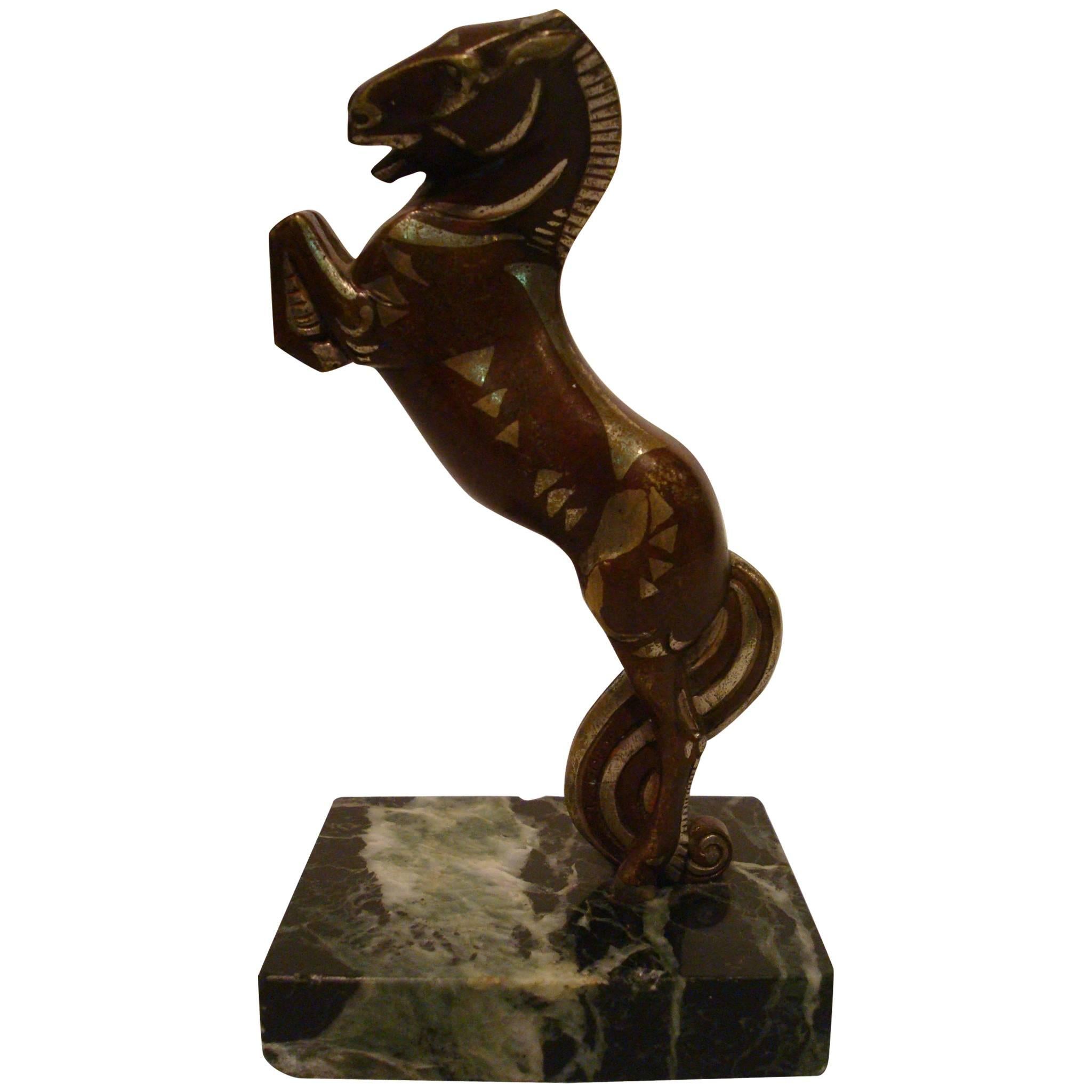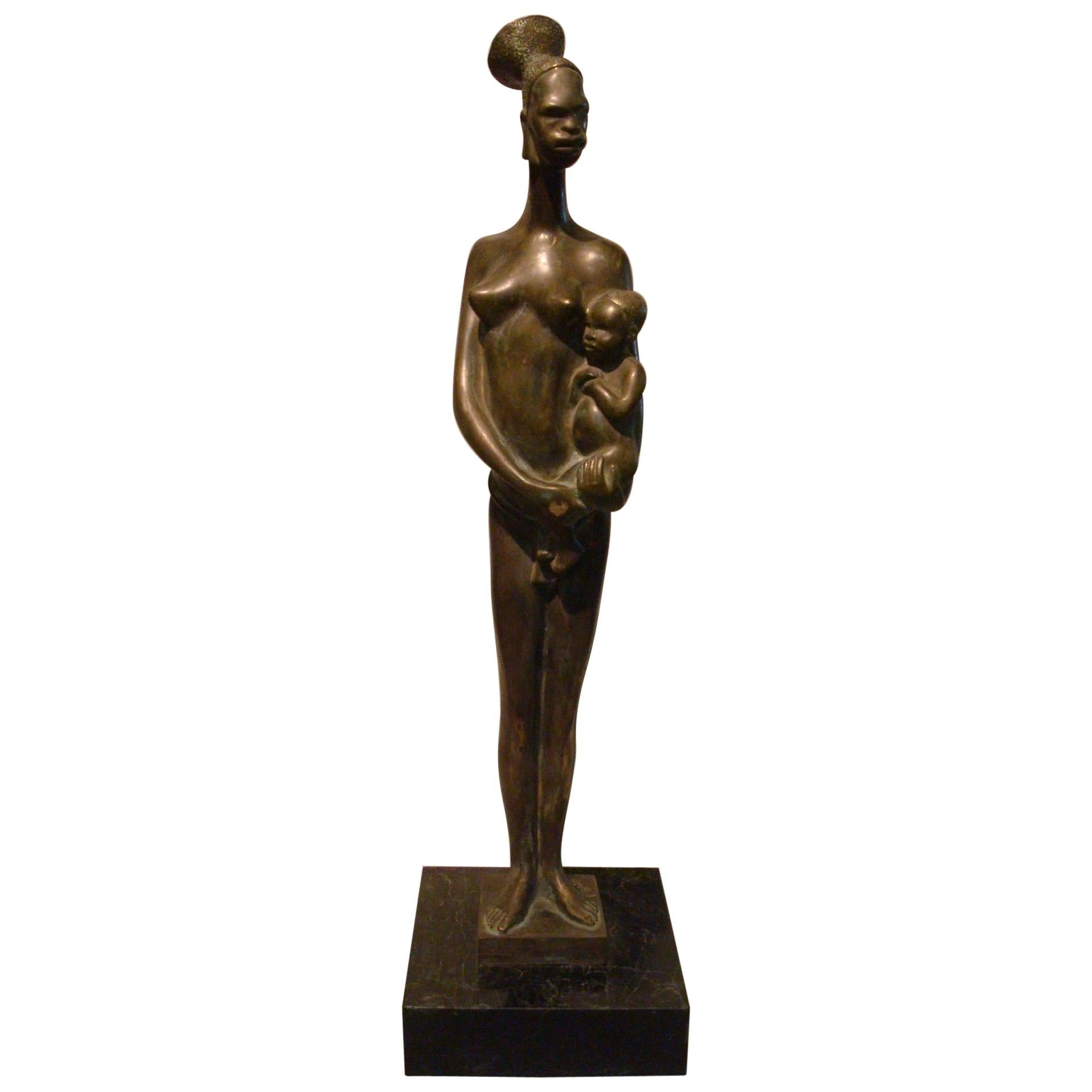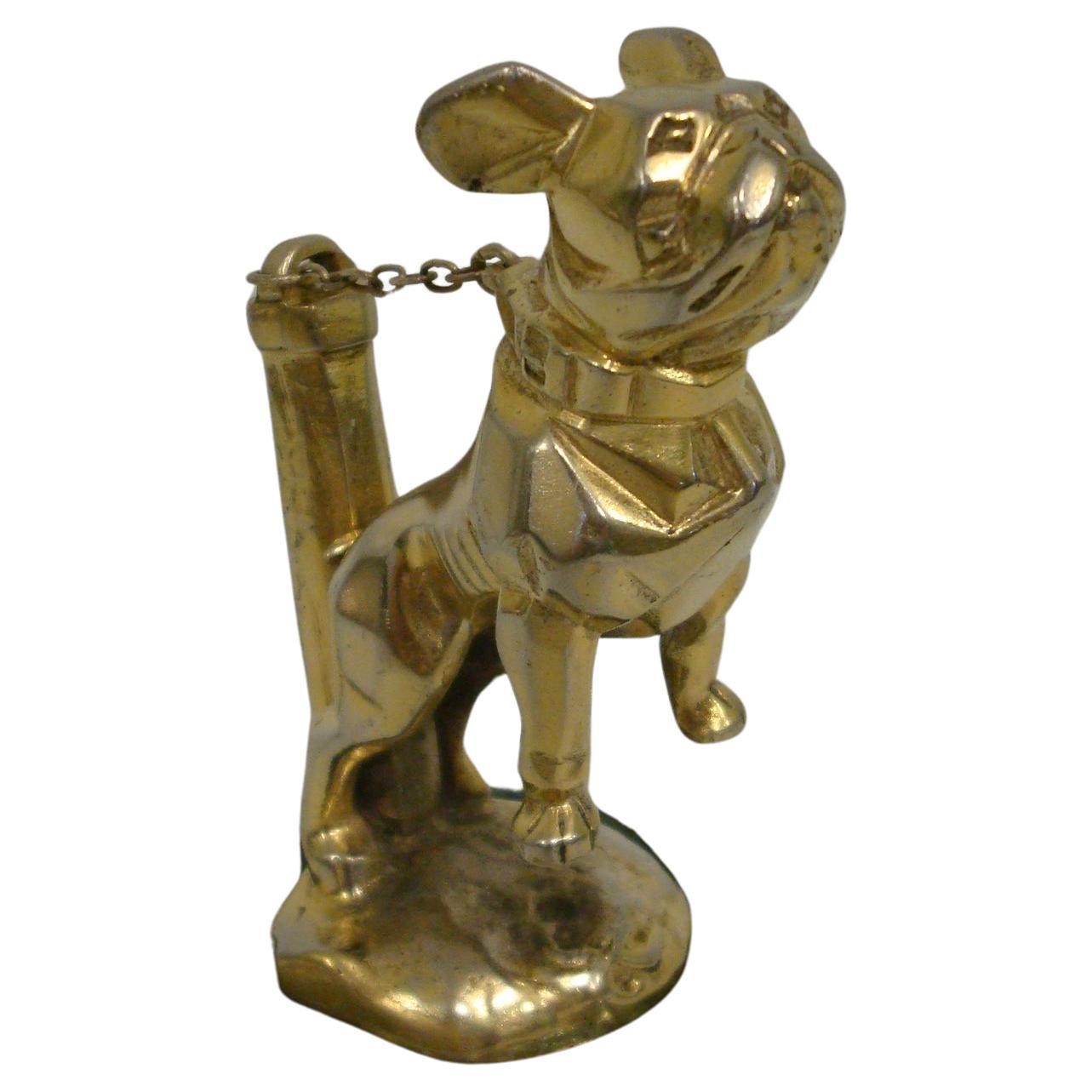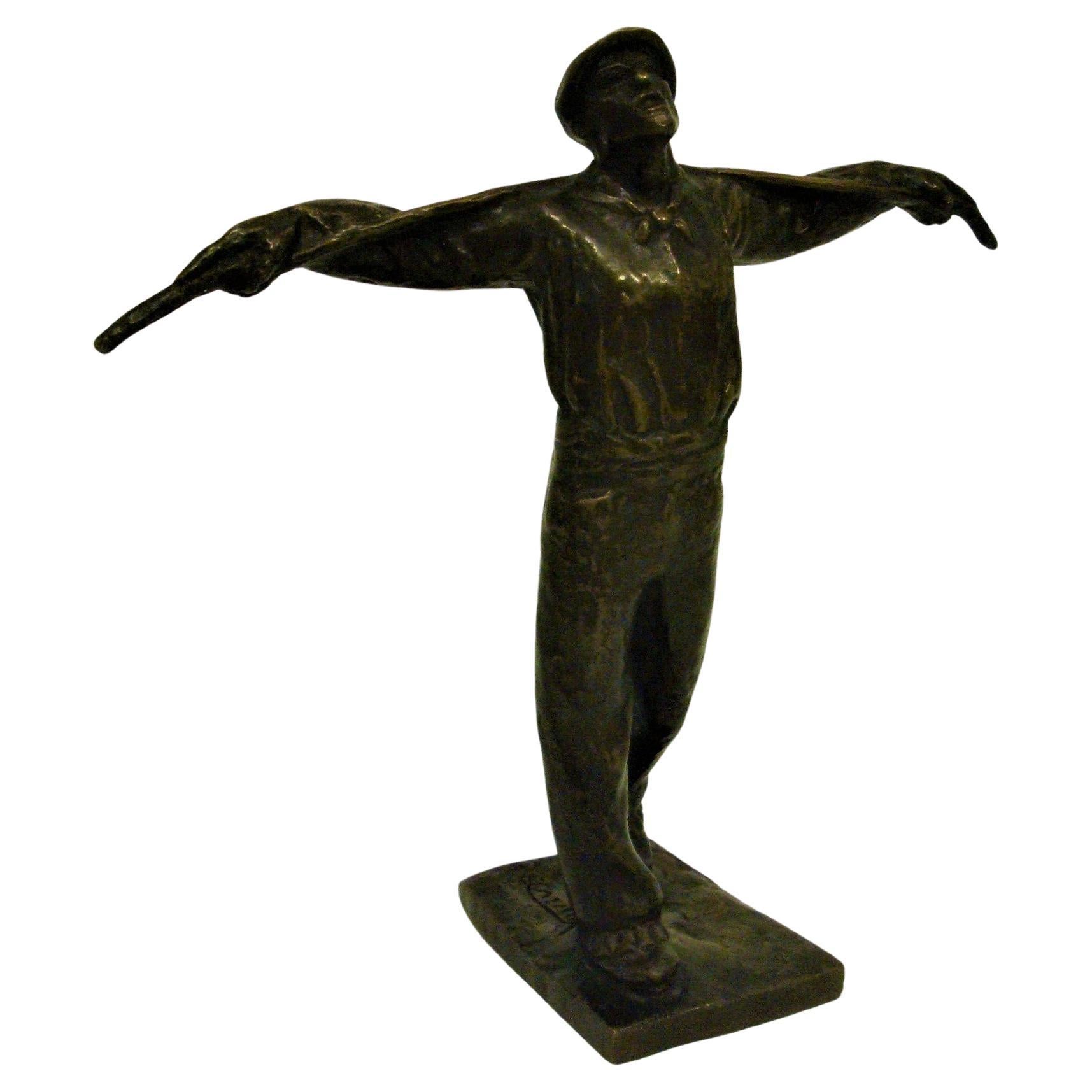Items Similar to Art Deco, Cubist Lying Women Sculpture by Pablo Curatella Manes, 1920s
Want more images or videos?
Request additional images or videos from the seller
1 of 10
Art Deco, Cubist Lying Women Sculpture by Pablo Curatella Manes, 1920s
About the Item
Art Deco, Cubist figure of a lying lady. Called by the Artist The Lying Nymph. Made between 1921-1926. Terracotta over a black wooden base.
Bio:
Pablo Curatella Manes (December 14, 1891–November 14, 1962) was a prolific Argentine sculptor.
Born in La Plata in 1891 to Clara Manes, a Greek Argentine immigrant, and Antonio Curatella, from Italy, Curatella Manes first acquired an interest in sculpture during his frequent childhood visits to the newly inaugurated La Plata Fine Arts Museum. He entered the labor force in 1905, as a typographer in a printing house, though an accident some months later ended his career in that industry. Drawing on his childhood interest, he was taught the basics of sculpture by Arturo Dresco, who owned a local atelier.
The Curatellas relocated to Buenos Aires, where the young sculptor enrolled in the National Fine Arts School in 1907. A rebellious streak promptly led to his expulsion, though Curatella earned an apprenticeship in 1908, under Lucio Correa Morales, with whom he worked on a number of works commissioned by Public Parks Director Charles Thays. Following the 1910 elections, he created a commemorative gold medal for Vice President-elect Victorino de la Plaza, who secured a scholarship for Curatella that took him to Florence and Rome. Curatella traveled extensively in Italy, as well as much of Western Europe, touring the region's museums and cathedrals. On his return to Argentina in 1912, National Fine Arts School director Ernesto de la Cárcova nearly ordered the funds' repayment, objecting to travel and activities not covered by the scholarship, desisting from the punishment after being shown a folio of Curatella's prolific work.
His first Buenos Aires exhibit, in 1912, was followed by a return to Europe. He settled in the Montparnasse section of Paris and studied under Aristide Maillol and Emile-Antoine Bourdelle, but was forced to return home after the outbreak of World War I. In his native La Plata he opened an art gallery, the Salón de Otoño (Autumn Salon), in 1916. A brief return in 1917 to Paris, where Curatella worked under Maillol, Maurice Denis and Paul Sérusier, was eventually followed by a second scholarship, with which he settled in Paris in 1920. Studying under Henri Laurens, Juan Gris, Constantin Brâncu?i and Le Corbusier, Curatella explored Cubism, and his sculptures became more avant-garde; he also established his first atelier, where he acquired the habit of creating and destroying sculptures in a single day.
He married French painter Germaine Derbecqre in 1922 and in 1926, was given a post in the Argentine Embassy. Returning to Argentina in 1929, he exhibited Las Tres Gracias (The Three Graces), which marked a departure towards the Abstract which would typify his work in subsequent years. Commissioned to create wall reliefs for the Argentine Pavilion in the 1937 Paris Exhibition, Curatella returned to France and opened an atelier on rue Lauriston, in Paris. His monumental Tierra Argentina and Los Dos Hemisferios ("Argentina" and "The Two Hemispheres") earned him the honor of serving in the Paris Exhibition's sculpture jury, and following the event, he was made an Officer of the Légion d'honneur. Reappointed to the embassy in 1939 as a chargé d'affaires, Curatella oversaw the repatriation of Argentine nationals in France following the Nazi invasion of France in 1940. Following WWII, he oversaw the reopening of the Argentine Embassy, as well as the reconstruction of the Boulogne-Sur-Mer home where the hero of the Argentine War of Independence, General José de San Martín, died in 1850.
Curatella continued to sculpt during his diplomatic tenure, and was among those who in 1946 reinaugurated the Salon des Indépendants, an artists' society and exhibit series banned by the Vichy regime. He remained active in the salon until being transferred to the Embassy in Athens in 1949, upon which he donated thirty-one works to the Argentine government for the purpose of creating a museum of modern art (which were added to the National Museum of Fine Arts, instead). He contributed to Unesco festivals and was appointed to the organizing committee for Expo 58, while accepting a commission from architect Mario Roberto Álvarez for two reliefs, El Drama and La Comedia, for display in the public San Martín Theatre, inaugurated in 1960. Curatella returned to the diplomatic corps in 1958, as an official in the Argentine Embassy in Brussels, whereby he oversaw the Argentine pavilion at Expo 58 and was honored with the Order of Leopold. Invited as a commissioner of the 1961 Paris Biennale, he reopened his rue Lauriston atelier. His El Guitarrista and Torso Femenino were acquired by the Modern Art Museum of the City of Paris, but a sudden illness forced the noted sculptor to return to Buenos Aires, where he died in 1962, at age 70.
He lived to see his vision for the Buenos Aires Museum of Modern Art, which was opened in 1956 by art critic Rafael Squirru; a number of Curatella's works are among its collections.
- Creator:Pablo Curatella Manes (Artist)
- Dimensions:Height: 4.93 in (12.5 cm)Width: 8.86 in (22.5 cm)Depth: 3.15 in (8 cm)
- Style:Art Deco (In the Style Of)
- Materials and Techniques:
- Place of Origin:
- Period:
- Date of Manufacture:1921-1926
- Condition:Wear consistent with age and use.
- Seller Location:Buenos Aires, AR
- Reference Number:1stDibs: LU202739754771

About the Seller
4.9
Vetted Seller
These experienced sellers undergo a comprehensive evaluation by our team of in-house experts.
Established in 2002
1stDibs seller since 2016
284 sales on 1stDibs
Typical response time: <1 hour
- ShippingRetrieving quote...Ships From: Buenos Aires, Argentina
- Return PolicyThis item cannot be returned.
More From This SellerView All
- Art Deco, Cubist Becquerel Bronze Polo Horse with Original Patina, 1920sBy André Vincent Becquerel, Etling ParisLocated in Buenos Aires, OlivosFantastic polo or equestrian paperweight, car mascot, hood ornament, by French artist Becquerel. Signed. With foundry marks. With original Art Deco patina. Mounted over a marble base.Category
Vintage 1920s French Art Deco Paperweights
MaterialsMarble, Bronze
- Art Deco Bronze Sculpture of a African Women with a Child in Arms, France, 1920sBy Francois BazinLocated in Buenos Aires, OlivosLarge Art Deco naked African Women with a child in arms. France, 1920s Art Deco bronze sculpture of an African Women.Category
Early 20th Century French Art Deco Figurative Sculptures
MaterialsMarble, Bronze
- Art Deco Cubist Pelican Paperweight Desk Sculpture by G.H. Laurent, France, 1925By Georges H. LaurentLocated in Buenos Aires, OlivosArt Deco Cubist Pelican paperweight desk sculpture by G.H. Laurent, France, 1925. Art Deco cubist pelican figure mounted over a Italian marble. Dark Green original patina on the bir...Category
Early 20th Century French Art Deco Animal Sculptures
MaterialsMetal
- Art Deco Car Mascot, Chained French Bulldog, Hood Ornament, France 1920sLocated in Buenos Aires, OlivosArt Deco 'Chained Bulldog' Car Mascot / Hood Ornament designed by Marvel, French, 1920´s, silver-Gilt plated bronze, small version, 14cm long, compl...Category
Vintage 1920s French Art Deco Animal Sculptures
MaterialsBronze
- Art Deco Bronze Sculpture Rabbit by Eduard Marcel Sandoz, Susse Freres, 1920By Edouard-Marcel SandozLocated in Buenos Aires, OlivosArt Deco silver plated bronze sculpture of a rabbit hare. Lovely paperweight. Edouard Marcel Sandoz (1881-1973). Signature/ Marks: Ed.M. Sandoz - Susse Fre'...Category
Early 20th Century French Art Deco Animal Sculptures
MaterialsBronze
- Art Deco Working Man Bronze Sculpture, Edouard Cazaux, France, 1920'sBy Edouard CazauxLocated in Buenos Aires, OlivosArt Deco working man bronze sculpture. Edouard Cazaux. France 1920's. Edouard Cazaux is one of the most important artist associated with the French Art Deco movement. He was a sculp...Category
Early 20th Century French Art Deco Figurative Sculptures
MaterialsBronze
You May Also Like
- Initial Stamp, Art Deco, 1920sLocated in Greven, DEBeautiful and authentically preserved stamp for sealing wax.Category
Vintage 1920s French Art Deco Desk Sets
MaterialsMetal
- French Art Deco Pierrot Sculpture, 1920sBy Claire ColinetLocated in Saint-Amans-des-Cots, FRFrench Art Deco sculpture, France, 1920s. "Pierrot". Spelter and onyx. Height : 11.2"(28.5cm), Width : 8.7"(22cm), Depth : 4.5"(11.5cm). Very good conditionCategory
Vintage 1920s French Art Deco Figurative Sculptures
MaterialsOnyx, Spelter
- É. M. Sandoz, Art Deco Cubist Sculpture of Parrot in Carved Malachite, ca. 1920sBy Edouard-Marcel SandozLocated in New York, NYFrench Art Deco Édouard-Marcel Sandoz PARROT Cubist Sculpture in Carved Malachite Circa 1920 DIMENSIONS Height: 5.75 inches Width: 3-15/16 inches Depth: 1-15/...Category
Vintage 1920s French Art Deco Animal Sculptures
MaterialsMalachite
- Art Deco Inkwell Vienna, circa 1920sLocated in Wien, ATArt Deco inkwell Vienna, circa 1920s Original condition.Category
Vintage 1920s Austrian Art Deco Inkwells
MaterialsMetal, Nickel
- Art Deco French Sculpture of an AntelopeLocated in North Hollywood, CAVintage French Art Deco style brass metal animal sculpture of a leaping antelope, impala, gazelle, deer. Brass figurine in polished bass that serve as bookend or as individual decor...Category
Mid-20th Century American Art Deco Animal Sculptures
MaterialsBrass
- Art Deco Onyx Marble Catchall with Female SculptureLocated in New York, NYA brass female dancer sculpture and green onyx marble base vide-poche catchall, Art Deco period, circa early-20th century. Sculpture's head is resin and body with a gold overlay on b...Category
Early 20th Century European Art Deco Figurative Sculptures
MaterialsOnyx, Brass




